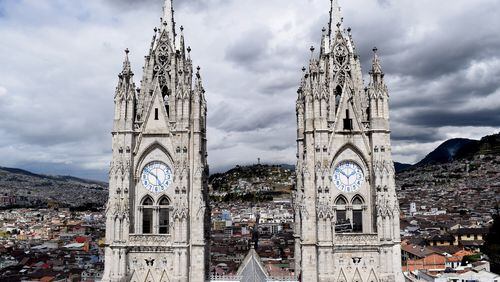QUITO, Ecuador — For more than 80 years, this Andean capital has been guarded by a strange array of kitschy castles — brimming with turrets and towers, spires and faux drawbridges, Moorish cupolas and sweeping staircases.
In a city internationally renowned for its colonial architecture (its historic center has been a United Nations World Heritage Site since 1978) the castillos de Quito have often been dismissed as architectural oddities and mid-century eyesores.
Despite being protected by the city, some have been destroyed outright and others have been modified beyond recognition. Of the 15 castles that Hector Lopez, a researcher who blogs about Quito’s architecture, has identified in the city, perhaps five retain much of their original charm, he said.
To understand how these Disney-worthy fortresses ended up in the South American highlands is to know the story of Ruben Vinci, a Mexican immigrant with a flair for the fantastic.
Vinci is thought to have arrived in Ecuador at the beginning of the 1900s and started working in the southern town of Riobamba. But his big break came in the 1930s when Carlos Larrea, an Ecuadorian diplomat and medieval scholar, approached Vinci about designing a home that reflected his interests.
What emerged was a three-story castle with multiple towers, a moat and a drawbridge — all surrounded by an English-style garden.
In the following years, Vinci was on a hot streak, building more than a dozen palazzos and castles for Quito’s high society.
Few know who Vinci is now, but “there was a time where he was super famous,” Lopez said. “He was even decorated by Ecuador’s congress.”
Romulo Moya Peralta, a member of the International Committee of Architectural Critics and the director of Quito’s architectural magazine, Trama, said Vinci’s buildings are an eclectic mix of medieval, neo-Gothic and neo-Moorish styles.
Vinci’s own home (now a restaurant) has a domed, Arabic-looking roof and walls studded with river rock. Another castle is being used as a political campaign headquarters and is splashed in garish orange and yellow, leading one tourist to speculate it might have been built by drug dons in the 1980s.
Whether or not the castles are considered in “good or bad” taste by today’s standards, they represent a special time in Quito’s history, Moya said. “These castles are unique and exceptional architectural works and deserve to be protected,” he added.
But even during the boom, there were the beginnings of a backlash, said Angelica Arias, the director of Quito’s Institute for Patrimony, which protects Ecuador’s historic buildings.
“They were very ornamental,” she said of the homes, “and at one time people were complaining that Quito looked like it was filling up with little cakes.” In other words, gaudy and overwrought houses.
But the castles were built unwittingly in enemy territory. Over the years, the Mariscal Sucre neighborhood, where most of the buildings are, became Quito’s new commercial hub.
Many of the residential castles were hastily turned into offices, hotels and restaurants. Their once-sweeping gardens became prime real estate to be sold off or developed — leaving some of them encased in other buildings, as if they were sinking into the city.
In 1984, Quito granted many of the castles architectural protection, but the economic forces were simply too strong, Arias said. In a neighborhood zoned for high rises, the castles were seen as a burden.
“People who owned the homes felt like they were being punished,” she said. “They were stuck with, say, a two-story house, while their neighbor could build a 10- or 12-story building.”
Owners sought loopholes and sometimes destroyed the buildings in the dead of night. At least four Vinci buildings were completely demolished and replaced by office buildings, Lopez said.
And the ones that have been saved often reflect the city’s economic tensions.
In 2013, a development group bought Castillo Larrea — Vinci’s original masterpiece with the moat and drawbridge — and built a 16-story tower next to it that dwarfs the once-imposing castle.
Arias said the developers followed the letter of the law (the bottom stories of the office complex are made out of glass so the building can be seen from the street) but she admits the castle’s “essence” is lost.
Lopez, the journalist, said the city made a mistake by not recognizing that the castles’ surroundings are also part of their architectural charm.
“At Castillo Larrea, the gardens are gone, the drawbridge is gone,” he said. “It’s a huge loss for the city.”
Just across from Larrea is one of Quito’s most intact castles. A staircase leads up past two lion statutes, through an ornate doorway — and into the “Rickie” department store.
Jose Cueva bought the building in 1979 but said it was never his intention to preserve it.
“I’m a merchant,” he explained on a recent weekend. “For me, everything is for sale except my wife and children.”
But over the years, after he has seen one castle after another fall to the twin forces of ridicule and real estate values, he has become protective. When a company recently offered him “good money” to turn the building into a gas station, he felt it was his civic duty to reject it.
“I’m a Quiteno, and I remember that this used to be one of the prettiest parts of the city,” he said. “I didn’t want to be part of the problem.”
It’s too soon to say the castles can survive the onslaught, but they are getting more recognition.
Arias said the municipality of Quito is reviewing its preservation plans and trying to find ways to provide incentives to castle owners “so they won’t see them as a burden.”
And Lopez recently started giving tours of the Mariscal Sucre neighborhood, where Vinci’s work plays a starring role.
“Our first tour was in December,” he said. “It was a total hit.”
About the Author






